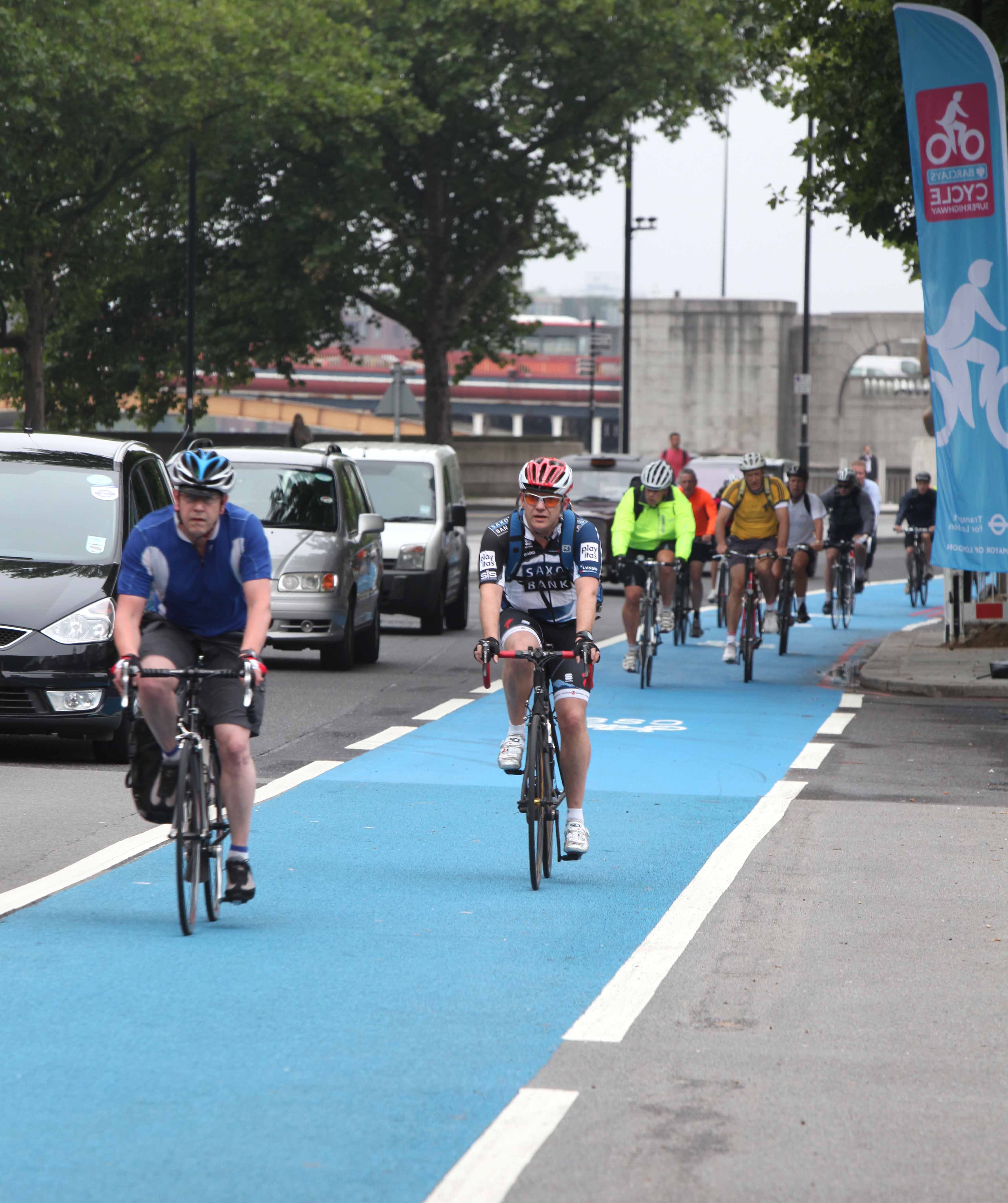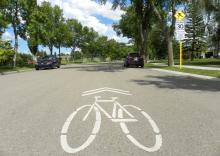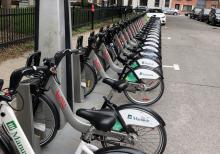A new UK report suggests local authorities should think twice about automatically incorporating cycle lanes in road design. David Arminas reports
Environmental and social arguments for getting more people onto bicycles are well known. The theory is the more people cycling, the less traffic congestion and less air pollution from cars. Well-defined cycle lanes can encourage people who might otherwise be too nervous to take to a bicycle.
But just how effective are cycle lanes for increasing the safety of

Coloured cycle lanes: is there a particular benefit?
A new UK report suggests local authorities should think twice about automatically incorporating cycle lanes in road design. David Arminas reports
Environmental and social arguments for getting more people onto bicycles are well known. The theory is the more people cycling, the less traffic congestion and less air pollution from cars. Well-defined cycle lanes can encourage people who might otherwise be too nervous to take to a bicycle.
But just how effective are cycle lanes for increasing the safety of cyclists?
Not as much as you might think, according to recent research by Kathryn Stewart, a lecturer in the Transport Institute at5954 Edinburgh Napier University in Scotland, and Adrian McHale, senior transport engineer at built environment consultancy RPS Group, in Newark-on-Trent, England. In fact, other factors are more important than the presence of cycle lanes that allow safe overtaking distances.
Stewart and McHale’s 11-page report, Cycle Lanes: their effect on driver passing distances in urban areas*, challenges assumptions about the effectiveness of cycle lanes.
In their study, the authors used bicycles equipped with cameras to record thousands of vehicle overtakes in varying road situations around Edinburgh. In the first half of the study, three situations were analysed: no cycle lane versus uncoloured lane; uncoloured cycle lane versus coloured lane; and no cycle lane versus coloured lane.
In the first comparison, no cycle lane versus an uncoloured cycle lane on roads around 9.4m wide, research showed the mean overtaking distance for all vehicles were greater, by 0.16m, when a cycle lane was present. But some overtakes happened when a vehicle was coming from the opposite direction. Even if these occurrences are taken out of the analysis, overtaking vehicles still gave the cyclist more room (0.12m) than if no cycle lane was present.
For the comparison of uncoloured cycle lane versus coloured lane, the roads were 9.4m to 9.8m wide and cycle lanes were 1.4m to 1.6m wide. Analysis found only a slight difference in overtaking difference of 0.02m more for vehicles passing cyclists in a coloured cycle lane, with or without the passing vehicle encountering oncoming traffic. This was not a “statistically significant difference”.
Finally, for no cycle lane versus coloured lane, both roads were 9.8m wide and the cycle lanes along the one road were 1.5m and 1.6m wide. The result was “no statistical difference (in overtaking distances) in any vehicle category in the urban 30mph environment”. The lack of a cycle lane meant drivers gave cyclists only 0.02m more room than when the cyclist was in a coloured cycle lane.
The second half of the study concerned other factors apart from cycle lanes that might affect a driver’s decision on overtaking distances.
Data was compiled for overtakes of 2.5m or less and then for overtakes of more than 2.5m.
For both sets of data, it found that the three most significant variables were road width, the presence of parked cars on the road and the presence of oncoming vehicles. All affected overtaking distances.
Generally, the wider the road, the wider the berth given to cyclists.
Regarding parked cars, the report noted the result was “logical”; parked cars meant a reduced road width allowing less room for a driver to move aside to overtake a cyclist.
Consider oncoming vehicles. The report said, again, “logically” overtaking distance decreases… “because when the road becomes busier, visibility is reduced and hence time for the driver to consider deviating from the path is reduced”.
Speeds of cyclist and driver also determined overtaking distances. The first set of data showed that “faster drivers generally provided more space when overtaking a cyclist”.
In the second set of data, “the faster the cyclist was going, the overtaking distances increased”.
The report concludes that overall road width, parking and opposing traffic are more significant factors than the provision of a cycle lane. Also, “there should be a presumption against the automatic provision of cycle lanes”, especially if they will be narrow in width.
But “reducing or calming of existing motorised traffic must be explored first, creating an attractive and welcoming environment” is foremost.
More work needs to be done, especially on driver’s behaviour.
The article in Transport magazine, published in September by Taylor & Francis, can be read %$Linker:2 External <?xml version="1.0" encoding="utf-16"?><dictionary /> 0 0 0 oLinkExternal online Online article false http://www.tandfonline.com/doi/abs/10.3846/16484142.2014.953205#.VLAEJXtwtqE false false %>
Environmental and social arguments for getting more people onto bicycles are well known. The theory is the more people cycling, the less traffic congestion and less air pollution from cars. Well-defined cycle lanes can encourage people who might otherwise be too nervous to take to a bicycle.
But just how effective are cycle lanes for increasing the safety of cyclists?
Not as much as you might think, according to recent research by Kathryn Stewart, a lecturer in the Transport Institute at
Stewart and McHale’s 11-page report, Cycle Lanes: their effect on driver passing distances in urban areas*, challenges assumptions about the effectiveness of cycle lanes.
In their study, the authors used bicycles equipped with cameras to record thousands of vehicle overtakes in varying road situations around Edinburgh. In the first half of the study, three situations were analysed: no cycle lane versus uncoloured lane; uncoloured cycle lane versus coloured lane; and no cycle lane versus coloured lane.
In the first comparison, no cycle lane versus an uncoloured cycle lane on roads around 9.4m wide, research showed the mean overtaking distance for all vehicles were greater, by 0.16m, when a cycle lane was present. But some overtakes happened when a vehicle was coming from the opposite direction. Even if these occurrences are taken out of the analysis, overtaking vehicles still gave the cyclist more room (0.12m) than if no cycle lane was present.
For the comparison of uncoloured cycle lane versus coloured lane, the roads were 9.4m to 9.8m wide and cycle lanes were 1.4m to 1.6m wide. Analysis found only a slight difference in overtaking difference of 0.02m more for vehicles passing cyclists in a coloured cycle lane, with or without the passing vehicle encountering oncoming traffic. This was not a “statistically significant difference”.
Finally, for no cycle lane versus coloured lane, both roads were 9.8m wide and the cycle lanes along the one road were 1.5m and 1.6m wide. The result was “no statistical difference (in overtaking distances) in any vehicle category in the urban 30mph environment”. The lack of a cycle lane meant drivers gave cyclists only 0.02m more room than when the cyclist was in a coloured cycle lane.
The second half of the study concerned other factors apart from cycle lanes that might affect a driver’s decision on overtaking distances.
Data was compiled for overtakes of 2.5m or less and then for overtakes of more than 2.5m.
For both sets of data, it found that the three most significant variables were road width, the presence of parked cars on the road and the presence of oncoming vehicles. All affected overtaking distances.
Generally, the wider the road, the wider the berth given to cyclists.
Regarding parked cars, the report noted the result was “logical”; parked cars meant a reduced road width allowing less room for a driver to move aside to overtake a cyclist.
Consider oncoming vehicles. The report said, again, “logically” overtaking distance decreases… “because when the road becomes busier, visibility is reduced and hence time for the driver to consider deviating from the path is reduced”.
Speeds of cyclist and driver also determined overtaking distances. The first set of data showed that “faster drivers generally provided more space when overtaking a cyclist”.
In the second set of data, “the faster the cyclist was going, the overtaking distances increased”.
The report concludes that overall road width, parking and opposing traffic are more significant factors than the provision of a cycle lane. Also, “there should be a presumption against the automatic provision of cycle lanes”, especially if they will be narrow in width.
But “reducing or calming of existing motorised traffic must be explored first, creating an attractive and welcoming environment” is foremost.
More work needs to be done, especially on driver’s behaviour.
The article in Transport magazine, published in September by Taylor & Francis, can be read %$Linker:






